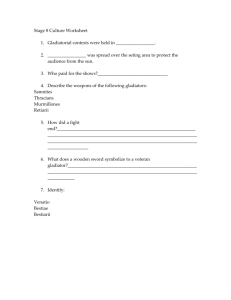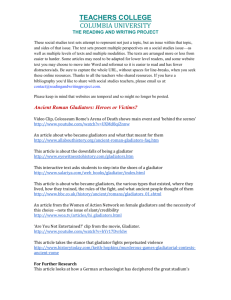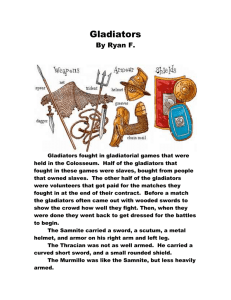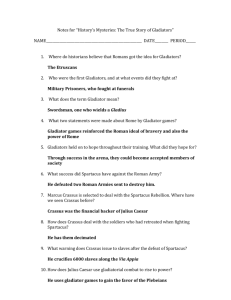Feb 27 – Roman Entertainment
advertisement
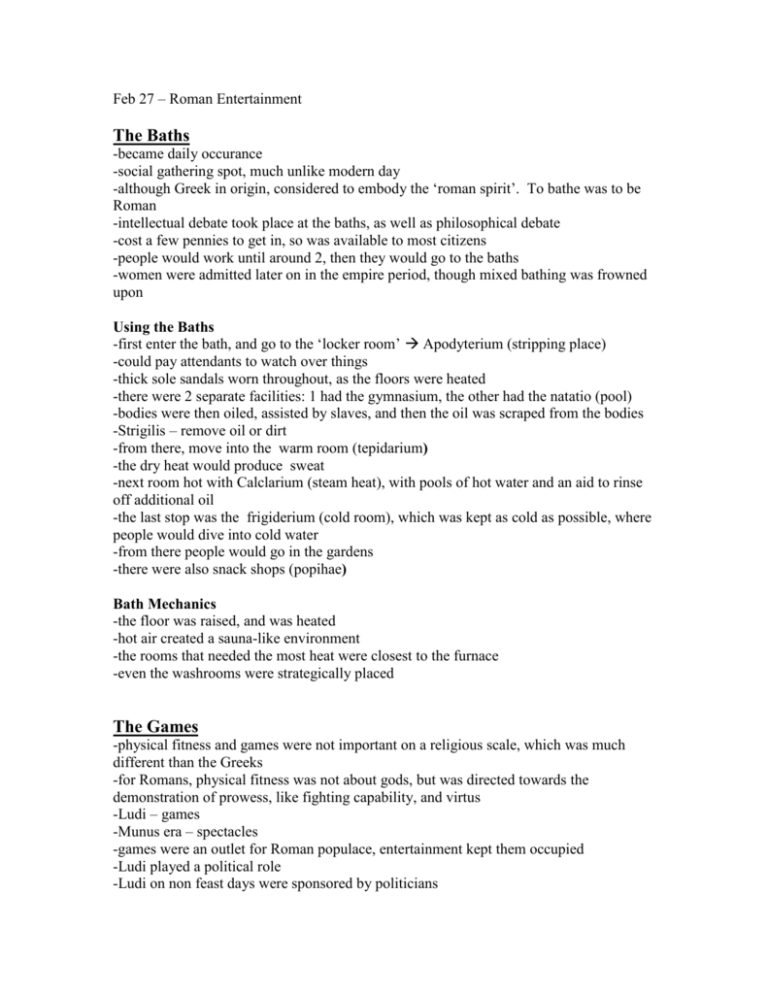
Feb 27 – Roman Entertainment The Baths -became daily occurance -social gathering spot, much unlike modern day -although Greek in origin, considered to embody the ‘roman spirit’. To bathe was to be Roman -intellectual debate took place at the baths, as well as philosophical debate -cost a few pennies to get in, so was available to most citizens -people would work until around 2, then they would go to the baths -women were admitted later on in the empire period, though mixed bathing was frowned upon Using the Baths -first enter the bath, and go to the ‘locker room’ Apodyterium (stripping place) -could pay attendants to watch over things -thick sole sandals worn throughout, as the floors were heated -there were 2 separate facilities: 1 had the gymnasium, the other had the natatio (pool) -bodies were then oiled, assisted by slaves, and then the oil was scraped from the bodies -Strigilis – remove oil or dirt -from there, move into the warm room (tepidarium) -the dry heat would produce sweat -next room hot with Calclarium (steam heat), with pools of hot water and an aid to rinse off additional oil -the last stop was the frigiderium (cold room), which was kept as cold as possible, where people would dive into cold water -from there people would go in the gardens -there were also snack shops (popihae) Bath Mechanics -the floor was raised, and was heated -hot air created a sauna-like environment -the rooms that needed the most heat were closest to the furnace -even the washrooms were strategically placed The Games -physical fitness and games were not important on a religious scale, which was much different than the Greeks -for Romans, physical fitness was not about gods, but was directed towards the demonstration of prowess, like fighting capability, and virtus -Ludi – games -Munus era – spectacles -games were an outlet for Roman populace, entertainment kept them occupied -Ludi played a political role -Ludi on non feast days were sponsored by politicians -Circus games were held in circular theatre, while spectators sat on hill slopes Chariot Racing -appealed to slaves and to the consuls -Auriga charioteer -Successful racers would get money (peculia) and could buy freedom -4 major teams in the beginning:Red, White, Blue, Green -these factions established club houses, similar to guilds -racers could gain a lot of popular support by winning Racing Details -usually 12 races a day -racers drew lots for positions in the starting gate -the races were very dangerous, due to the turning stake setup, and the racers roughhousing -the winner would win a palm branch, wreath, with more rewards received later Gladiators -Pompa a parade held by magistrates who were sponsoring a gladiator fight -Romans believed to have inherited gladiatorial games from Etruscans -developed from the funeral games and festivals -slaves would fight to death in honor of the deceased -Munus duty/gift -Duty that is owed to the dead -this fighting became very popular -“give them vitality by spilling blood” -Dis Manibus to the gods of the dead (loveless dead) -the Roman culture became obsessed with it -Caesar puts on 320 matches over 3 days for his daughter Julia -Competition becomes dangerous -gladiator spectacles later fell into the hands of the emperor to put on -Romans believed that whoever performed public entertainment were slaves in a sense -Whoever could fight well, gained crowd support -Could get their life and freedom back, by being manumitted, where they become a person -Rudus – wooden sword, symbol of being manumitted -you could not do much if you held a grudge against a gladiator who the people loved. You cannot fight a mob -Romans made lives out of violence, which is reflected in their love of gladiator combat -the Romans made their empire with a bit of diplomacy, and a lot of bloodshed -was also a display of Roman power: they could use up lives for their own entertainment -historic battles were reenacted in gladiator groups -still shows that they have power over people -Some people did object to the fights: Seneca -gladiators had to be trained, or had to be tough or a soldier -Those who survived, became part of the school (Schola) -Lanista – manager of gladiators, who would ensure they received the best medical care, to keep profits up -Lanista benefited from keeping gladiators alive, didn’t have to buy more Venatio -Hunt -Spectacles containing animals: -Animals vs. animals -Animals vs. humans -the people were protected by nets and cages below -archers were also on the wall as a last resort -Venator was below gladiator -bestiaries (beast master) was below venator -showed that Romans had power to overcome wild beasts and control them -Caracotta – similar to the hyena, now extinct from gladiator sports in Italy Day of Games Order -Venatios comes first -lunch break, followed by executions for capital crimes -then there was more gladiator sport: first fist to fist, then heavily armed fights -Roman executions were sometimes staged as mythological reenactments Gladiator Lifestyle -Associations were made with ethnic groups (Spaniards, Greeks, etc) -people were recruited when there wasn’t enough people -captured soldiers were thrown into the arena -Gladiators could become infamous -Some chose it as career, giving up their rights to join -5 conditions of gladiators -being branded with a permanent tattoo (mark of stigma) -Agree to being charged – Catenatus -Agree to be subjected to Iron – Ferratus -Agree to pay for all of this with blood – Sanguis -Agree to patience/suffering/endurance – Patientia -they became slaves with benefits -roughly half of the gladiator population was free who had taken the gladiator oath -gladiators got 3 meals a day, medical care, a place to sleep, security, and peculia -gladiators could survive to win their freedom -woman gladiators existed as well, later on -women were rare, and were also treated better -Pompei first man to bring women to the arena -women gladiators complicated the idea of virtus, it had to be expanded to include them
